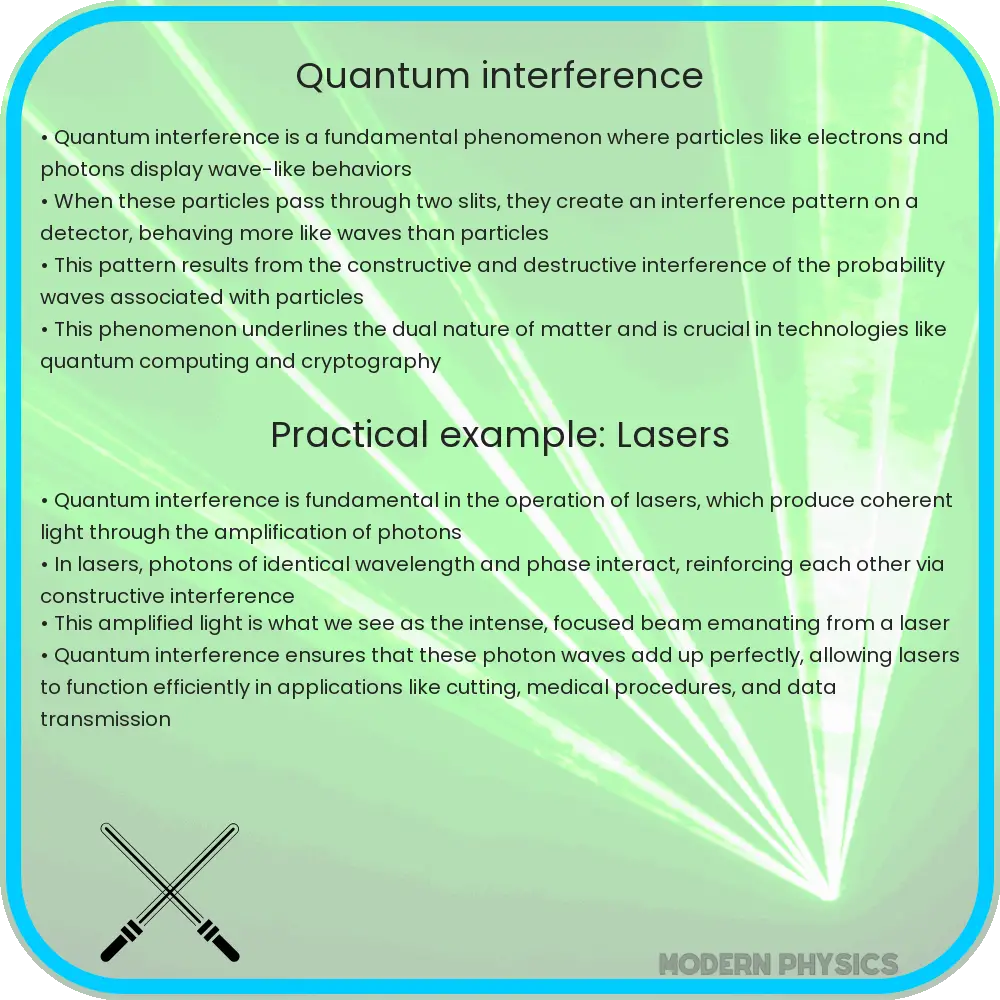Quantum interference, a core quantum physics concept, reveals the wave-like nature and probability amplitudes of particles like electrons and photons, leading to phenomena such as the double-slit experiment.

Understanding Quantum Interference
Quantum interference is a fundamental concept in the realm of quantum physics, illustrating the peculiar behaviors of particles at the smallest scales imaginable. Unlike what we see in our everyday life, quantum particles such as electrons, photons, or atoms can exhibit behaviors that challenge our classical understanding of the world. In this article, we delve into the principles of quantum interference and explore some of its striking examples.
Principles of Quantum Interference
Quantum interference arises from the wave-like nature of particles. In quantum mechanics, each particle is described not just as a particle, but as a wave of probabilities, known as a wavefunction. This wavefunction describes the probability amplitude of a particle’s presence at various places and times. When two wavefunctions overlap, they interfere with each other.
The interference can be either constructive or destructive, depending on the phase difference between the interacting wavefunctions. When the peaks of two waves align, they amplify each other, leading to constructive interference; conversely, when a peak and a trough align, they cancel each other out, causing destructive interference.
This phenomenon is famously demonstrated in the double-slit experiment. When particles such as electrons or photons pass through two closely spaced slits, instead of forming two distinct lines corresponding to the slits, they create an interference pattern of multiple lines on a detector screen. This pattern results from the wavefunctions of particles passing through each slit and then interfering with each other.
Quantum Superposition
At the heart of quantum interference lies the principle of quantum superposition. This principle states that any quantum system can exist simultaneously in multiple states until it is measured. In the context of quantum interference, this means that a particle travels through both slits simultaneously in the double-slit experiment, with each path represented by a different component of the wavefunction.
The resultant interference pattern is a direct manifestation of the superposition, providing some of the most compelling evidence for this bizarre quantum effect. It tells us that the act of measuring, or observing, a quantum system affects its state profoundly—often referred to as the “observer effect”.
Examples of Quantum Interference
1. Double-Slit Experiment: As previously mentioned, this is the most iconic demonstration of quantum interference. The experiment can be performed with various particles, and each time it remarkably shows the same interference patterns, highlighting the universal nature of quantum mechanics.
2. Quantum Computing: Quantum bits or qubits, used in quantum computers, exploit the principle of superposition, and consequently, interference, to perform computations. By controlling the interference patterns between the quantum states of these qubits, quantum computers can process information in ways that are fundamentally unachievable by classical computers.
3. Bose-Einstein Condensates: When particles known as bosons are cooled to temperatures near absolute zero, they can condense into a single quantum state, forming what is known as a Bose-Einstein condensate. The behavior of these condensates, including their flow without friction (superfluidity), is a macroscopic display of quantum interference.
The implications of quantum interference span various scientific and technological fields, from fundamental physics to advanced computing. As we continue to explore, we unlock further nuances and potential applications of this quintessential quantum phenomenon.
Impact and Applications
Quantum interference is not just a fascinating scientific concept, but it also has practical applications that are transforming technology. For instance, the development of quantum sensors exploits interference effects to achieve unprecedented sensitivity and resolution. These sensors are capable of detecting everything from magnetic fields to gravitational changes, and they are expected to revolutionize fields like navigation, medical imaging, and archaeology.
Furthermore, the principles of quantum interference are integral to the emerging technologies of quantum encryption and quantum communication. These technologies promise vastly improved security for data transmission, exploiting the fundamental properties of quantum mechanics to protect data from eavesdroppers.
- Quantum Encryption: Utilizes the principles of quantum mechanics to encrypt data in a way that any attempt at eavesdropping changes the encryption key, thus alerting the communicating parties.
- Quantum Communication: Involves the transmission of quantum bits (qubits) over long distances without loss of information, using quantum repeaters enhanced by the interference of quantum states.
Conclusion
Quantum interference embodies the intrigue and complexity of quantum physics. It challenges our classical intuitions about the world, presenting a reality where particles can exist in multiple states simultaneously and interact in ways that can only be described through probabilities. Through seminal experiments like the double-slit experiment and cutting-edge applications in computing, encryption, and sensing, quantum interference continues to be a central pillar in our understanding and application of quantum mechanics.
As we dive deeper into the quantum world, our grasp of phenomena like quantum interference opens up new avenues for technological innovation and provides profound insights into the fabric of the universe. For students, hobbyists, and experts alike, quantum interference serves as a gateway to the broader and often bewildering world of quantum physics, a field that holds promises to revolutionize our technological landscape and expand our theoretical horizons.
